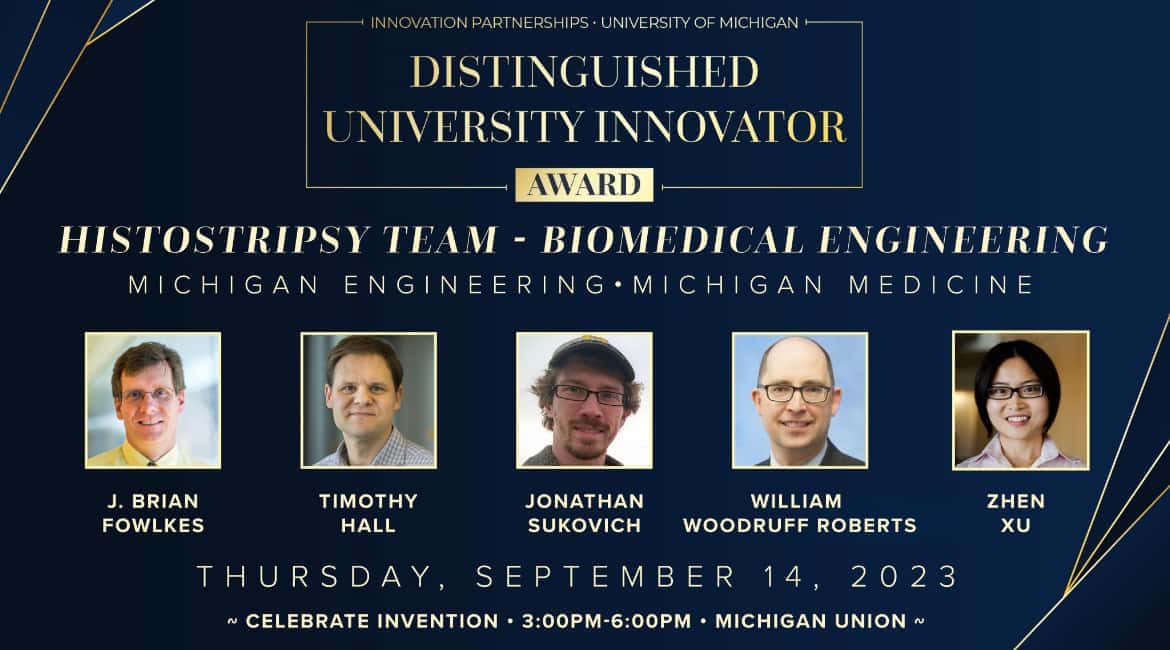
Histotripsy researchers receive Distinguished University Innovator Award
Technology holds promise to permit patients with diseased tissue to obtain treatment with less discomfort and faster recovery times than traditional surgery.

Technology holds promise to permit patients with diseased tissue to obtain treatment with less discomfort and faster recovery times than traditional surgery.
Histotripsy, a term coined by University of Michigan researchers, is a technique that uses sound waves to break down diseased tissue. Designed as a noninvasive alternative to surgical procedures, the novel technology uses focused ultrasound to mechanically disrupt target tissue, as opposed to thermal ablation.
The technology holds promise to permit patients with diseased tissue, such as cancerous tumors, to obtain treatment with less discomfort and faster recovery times than traditional surgery.
A team led by researchers from the College of Engineering and the Medical School invented and developed histotripsy, and their efforts to bring it to the clinic to address human disease has earned them this year’s Distinguished University Innovator Award. The team members are:
The Distinguished University Innovator Award is the highest honor for U-M faculty members who have developed transformative ideas, processes or technologies and shepherded them to market for broad societal impact. It was established in 2007 and is supported by endowments from the Office of the Vice President for Research and the Stephen and Rosamund Forrest Family Foundation.
“What distinguishes the University of Michigan as a leading public research university is our shared perpetual pursuit of innovative solutions to the greatest challenges impacting communities across the globe,” said Rebecca Cunningham, vice president for research and the William G. Barsan Collegiate Professor of Emergency Medicine.
“Together, we are persistent in our mission to serve the people of Michigan and the world, and as part of this collective commitment, we will continue to support our research discoveries and help translate them into real-world tools and services. What the histotripsy team has developed is a prime example of innovative research that needs to be shared broadly with the world.”
OVPR selected this year’s award recipients based on the recommendation of a diverse faculty selection committee that reviews a pool of nominees. The histotripsy team will receive the award Sept. 14 at the annual Celebrate Invention event at the Michigan Union.
“This highly collaborative team has developed a breakthrough idea with innovative hardware and software to enable the histotripsy process,” said Mary-Ann Mycek, professor of biomedical engineering and interim chair of the department, which is jointly housed in CoE and the Medical School.
“They’ve published a tremendous amount of data showing histotripsy’s disruptive and transformational potential, created a new subfield and formed a company that is making outstanding progress toward clinical translation and commercialization. The contributions they’ve made are substantial, and I look forward to seeing the team’s future innovations.”
A startup company based on histotripsy, HistoSonics, was launched in 2010 with support from Innovation Partnerships, a unit based in OVPR that serves as a central hub to lead U-M research commercialization efforts.
While minimally invasive and noninvasive technologies are routinely used in the clinic, they have limitations such as bleeding, infection, radiation and heat induced complications. HistoSonics has developed the Edison System, the first noninvasive, non-ionizing and non-thermal procedure to destroy targeted tissues that is guided by real-time imaging, alleviating the limitations of earlier versions. It has accomplished what has been out of reach for others — successfully using sound wave energy to mechanically obliterate diseased tissue.
“We are grateful for the support we received from the University of Michigan on our journey to invent histotripsy and develop it into a platform that can be leveraged broadly to treat patients,” Xu said.
“We would not have accomplished all that we have and come as far as we have without Innovation Partnerships. They have been with us every step of the way to go from an inventor mindset to commercialization.”
HistoSonics now employs more than 100 people and has raised more than $200 million. With a presence in Ann Arbor, HistoSonics embodies what the university strives for in its research commercialization efforts — it not only delivers a product or service that positively impacts patients, it also generates a significant economic impact.
“One of the best parts about science is turning the impossible to possible,” Xu said. “What our team has accomplished by providing an incisionless, non-toxic, painless way to destroy disease tissue via sound wave energy is incredible. I’m excited about the potential of histotripsy to change the field of medicine and cancer treatment, and eventually extend to treat many other disease types beyond cancer, such as stroke, neurological diseases, cardiovascular diseases and skin diseases.”